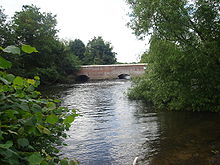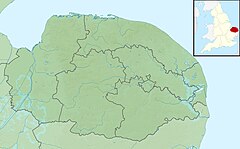River Wensum
| Wensum | |
|---|---|
 The River Wensum in Norwich | |
| Location | |
| Country | England |
| Counties | Norfolk |
| Towns | Sculthorpe, Fakenham, North Elmham, Lenwade, Norwich |
| Physical characteristics | |
| Source | |
| • location | Whissonsett, Norfolk |
| • coordinates | 52°47′30″N 0°50′47″E / 52.7917°N 0.8464°E |
| Mouth | River Yare |
• location | Whitlingham, Norwich |
• coordinates | 52°37′17″N 1°19′23″E / 52.6213°N 1.3230°E |
| Discharge | |
| • location | Costessey Mill |
| • average | 4.05 m3/s (143 cu ft/s) |
| • minimum | 0.36 m3/s (13 cu ft/s) 6 August 1991 |
| • maximum | 34.0 m3/s (1,200 cu ft/s) 29 January 1984 |
| Discharge | |
| • location | Swanton Morley |
| • average | 2.76 m3/s (97 cu ft/s) |
| Discharge | |
| • location | Fakenham |
| • average | 0.87 m3/s (31 cu ft/s) |
| Basin features | |
| Tributaries | |
| • left | River Tat, River Ainse (or Eyn) |
| • right | River Tud |
The River Wensum is a
The Wensum is the principal river on which the city of Norwich was founded.[7] The river passes Carrow Road, the home of Norwich City F.C.; one end of the ground was originally named The River End in its honour, a name that still persists among fans.[8]
Etymology
The river receives its name from the Old English adjective wandsum or wendsum, meaning "winding".[9]
Course



Modern Ordnance Survey Maps list the source of the Wensum as lying between the villages of
The Wensum continues through or close to the villages of
The Wensum flows past Carrow Road football ground and then out of the city via Trowse to Whitlingham and its confluence with the River Yare. The Wensum is navigable from New Mills Yard in the centre of Norwich.
Tributaries
- River Tat. Rises on Syderstone Common and merges with the Wensum west of Fakenham
- East Dereham and merges with the Wensum just below Hellesdonmill.
- River Ainse. Merges with the River Wensum at Lenwade.
Watermills



There were a succession of
- Sculthorpe Mill. The 18th century water mill which bridges the river was converted into a hotel and restaurant in 2003.[14]
- Hempton Mill. The mill became derelict and was demolished in 1954 by the Drainage Board to improve control of the river levels.[15]
- Fakenham Mill. The 18th Century water mill bridging the river was in use until 1979. It was converted into homes in 1982.[16]
- Great Ryburgh Mill[17]
- Guist Mill[18]
- Bintry Mill ceased operation in 1980, but the building is still extant. It was used as the location for a film of George Eliot's The Mill on the Floss in 1996.[19]
- North Elmham Mill, known locally as Grint Mill, had two breastshot waterwheels until the early twentieth century when they were replaced by two turbines. By the 1970s the milling machinery was driven by mains electricity while the turbines were used to drive a sack hoist and two mixing machines. The mill continued to produce animal feed into the late twentieth century.[20]
- Swanton Morley Mill was demolished in the 1840s.[21]
- Elsing Mill ceased operation in 1970. The building is still extant.[22]
- Lyng Mill was demolished in 1868.[23]
- Lenwade Mill. The Grade II listed building was at risk in the 1990s, but was sympathetically converted into apartments in 2000.[24]
- Taverham Mill. In the 19th century Taverham was a major producer of paper. Some of the paper which was produced at Taverham Mill was used in producing The Times and the Oxford English Dictionary. It also served the University Press at Cambridge. The paper mill closed in 1899.[25]
- Costessey Mill was destroyed by a fire in 1924.[26]
- Hellesdon Mill was demolished for building materials in 1920.[27]
- Norwich New Mills. A corn mill was built in 1430 by public subscription. In 1710, it was rebuilt to grind corn and supply water to the city. In 1897, it became an air compressor station, with three electric and two water powered compressors. The compressed air was used to pump sewage out of the city. Operation ceased in 1972, when the only other Shone Ejector pumps in the country were those under the Houses of Parliament. Plans for it to become a working museum failed, but all the machinery is still intact. The sluice is now computer operated to control water levels.[28]
Other mills close on tributaries are
- Great Witchingham Mill[29]
- Gressenhall Mill[30]
- Worthing Mill[31]
- Felthorpe Mill[32]
River Wensum bridges
River Wensum | |||||||||||||||||||||||||||||||||||||||||||||||||||||||||||||||||||||||||||||||||||||||||||||||||||||||||||||||||||||||||||||||||||||||||||||||||||||||||||||||||||||||||||||||||||||||||||||||||||||||||||||||||||||||||||||||||||||||||||||||||||||||||||||||||||||||||||||||||||||||||||||||||||||||||||||||||||||||||||
|---|---|---|---|---|---|---|---|---|---|---|---|---|---|---|---|---|---|---|---|---|---|---|---|---|---|---|---|---|---|---|---|---|---|---|---|---|---|---|---|---|---|---|---|---|---|---|---|---|---|---|---|---|---|---|---|---|---|---|---|---|---|---|---|---|---|---|---|---|---|---|---|---|---|---|---|---|---|---|---|---|---|---|---|---|---|---|---|---|---|---|---|---|---|---|---|---|---|---|---|---|---|---|---|---|---|---|---|---|---|---|---|---|---|---|---|---|---|---|---|---|---|---|---|---|---|---|---|---|---|---|---|---|---|---|---|---|---|---|---|---|---|---|---|---|---|---|---|---|---|---|---|---|---|---|---|---|---|---|---|---|---|---|---|---|---|---|---|---|---|---|---|---|---|---|---|---|---|---|---|---|---|---|---|---|---|---|---|---|---|---|---|---|---|---|---|---|---|---|---|---|---|---|---|---|---|---|---|---|---|---|---|---|---|---|---|---|---|---|---|---|---|---|---|---|---|---|---|---|---|---|---|---|---|---|---|---|---|---|---|---|---|---|---|---|---|---|---|---|---|---|---|---|---|---|---|---|---|---|---|---|---|---|---|---|---|---|---|---|---|---|---|---|---|---|---|---|---|---|---|---|---|---|---|---|---|---|---|---|---|---|---|---|---|---|---|---|---|---|---|---|---|---|---|---|---|---|---|---|---|---|---|---|---|---|---|
| |||||||||||||||||||||||||||||||||||||||||||||||||||||||||||||||||||||||||||||||||||||||||||||||||||||||||||||||||||||||||||||||||||||||||||||||||||||||||||||||||||||||||||||||||||||||||||||||||||||||||||||||||||||||||||||||||||||||||||||||||||||||||||||||||||||||||||||||||||||||||||||||||||||||||||||||||||||||||||
Jarrold Bridge is a footbridge linking the St James Place business park to Bishopgate.
Fye Bridge is arguably the oldest river crossing in Norwich and is the gate to the North of the City known as "
Whitefriars Bridge Named after a former
Foundry Bridge Near the railway station and the Yacht station on Riverside named after a foundry nearby, purported to have been built to take a railway line.
Lady Julian Bridge is a footbridge named after Julian of Norwich that links Riverside to King Street.
Carrow Bridge near Carrow Road football ground is a more recent cantilevered swing bridge, which can still be opened to allow large or high vessels through. It is positioned in close proximity to the Boom towers which originally had a chain suspended between them and would have been used as part of the city's defences and as a method of collecting tolls on goods travelling up river from Great Yarmouth.
Novi Sad Friendship Bridge is a cable stayed swing
There are further bridges at Barn Road, Anchor Quay, Duke Street and St. Georges Street.
Conservation
After many years of decline a survey was commissioned by
The Norfolk Anglers Conservation Association (NACA) carried out a successful river habitat restoration at their Sayers Meadow fishery at Lyng in the early 1980s.[35] After dredging and a major abstraction pipeline had a detrimental effect on the Costessey Point fishery, the association has taken action to restore this well known water. The ongoing work will be used as a blueprint for future river conservation projects.[36]
The Demonstration Test Catchment (DTC) project is a joint initiative between the Environment Agency,
Angling
Between 1940 and the 1970s the river had a national reputation as a
Today (2011), much of the Wensum's upper reaches are privately owned or controlled by syndicates. However, opportunities for individual anglers can be found and as the river passes through the City of Norwich free fishing is available where accessible.
See also
- List of rivers in England
References
- ^ a b c River Wensum restoration strategy, Natural England Retrieved 21 March 2011
- Encyclopaedia Britannica. Archived from the originalon 17 November 2017.
- ^ "Designated Sites View: River Wensum". Sites of Special Scientific Interest. Natural England. Retrieved 13 June 2018.
- ^ "Map of River Wensum". Sites of Special Scientific Interest. Natural England. Retrieved 13 June 2018.
- ^ "Designated Sites View: River Wensum". Special Areas of Conservation. Natural England. Retrieved 1 June 2018.
- ^ River Wensum, Special area of conservation, Joint Nature Conservation Committee Retrieved 13 October 2008
- Encyclopaedia Britannica. Archived from the originalon 10 July 2018.
- ^ Cuffley, David (22 January 2011). "Boosting Norwich City crowd potential would turn back the clock". Norwich Evening News. Retrieved 11 June 2015.
- ISBN 0-19-869103-3
- ^ ISBN 9780319262306.
- ^ "Historical Maps of Norfolk". www.historic-maps.norfolk.gov.uk. Retrieved 20 February 2021.
- ^ Mee, Arthur (1946). The King's England: Norfolk. Hodder & Stoughton.
- ^ Cow Tower Archived 26 January 2011 at the Wayback Machine Retrieved 15 December 2010
- ^ "Norfolk Mills - Sculthorpe watermill". www.norfolkmills.co.uk. Retrieved 10 October 2022.
- ^ "Norfolk Mills - Hempton watermill". www.norfolkmills.co.uk. Retrieved 10 October 2022.
- ^ "Norfolk Mills - Fakenham watermill". www.norfolkmills.co.uk. Retrieved 10 October 2022.
- ^ "Norfolk Mills - Gt Ryburgh watermill". www.norfolkmills.co.uk. Retrieved 10 October 2022.
- ^ "Norfolk Mills - Guist". www.norfolkmills.co.uk. Retrieved 10 October 2022.
- ^ "Norfolk Mills - Bintry watermill". www.norfolkmills.co.uk. Retrieved 10 October 2022.
- ^ "Norfolk Mills - North Elmham watermill". www.norfolkmills.co.uk. Retrieved 10 October 2022.
- ^ "Norfolk Mills - Swanton Morley watermill". www.norfolkmills.co.uk. Retrieved 10 October 2022.
- ^ "Norfolk Mills - Elsing watermill". www.norfolkmills.co.uk. Retrieved 10 October 2022.
- ^ "Norfolk Mills - Lyng watermill". www.norfolkmills.co.uk. Retrieved 10 October 2022.
- ^ "Norfolk Mills - Lenwade watermill". www.norfolkmills.co.uk. Retrieved 10 October 2022.
- ^ "Norfolk Mills - Taverham watermill". www.norfolkmills.co.uk. Retrieved 10 October 2022.
- ^ "Norfolk Mills - Costessey watermill". www.norfolkmills.co.uk. Retrieved 10 October 2022.
- ^ "Norfolk Mills - Hellesdon watermill". www.norfolkmills.co.uk. Retrieved 10 October 2022.
- ^ "Norfolk Mills - New Mills". www.norfolkmills.co.uk. Retrieved 10 October 2022.
- ^ "Norfolk Mills - Great Witchingham Mill". www.norfolkmills.co.uk. Retrieved 10 October 2022.
- ^ "Norfolk Mills - Gressenhall Mill". www.norfolkmills.co.uk. Retrieved 10 October 2022.
- ^ "Norfolk Mills - Worthing Mill". www.norfolkmills.co.uk. Retrieved 10 October 2022.
- ^ "Norfolk Mills - Felthorpe Mill". www.norfolkmills.co.uk. Retrieved 10 October 2022.
- ^ Design of the Novi Sad Friendship Bridge – A Case Study, accessed 14 March 2010
- ^ a b Environment Agency- River Wensum Restoration Strategy Retrieved 30 March 2011
- ^ a b Norfolk Anglers Conservation Association, Sayers Meadow, NACA Retrieved 23 March 2011
- ^ Costessey Point Retrieved 15 April 2011
- ^ River Wensum DTC Retrieved 28 February 2014
- ^ ISBN 0-7117-0183-0p23, 132. Jarrolds Retrieved 22 March 2011
- ^ Wensum barbel Retrieved 22 March 2011
Further reading
- Where to Fish in Norfolk and Suffolk by ISBN 0-7117-0183-0

